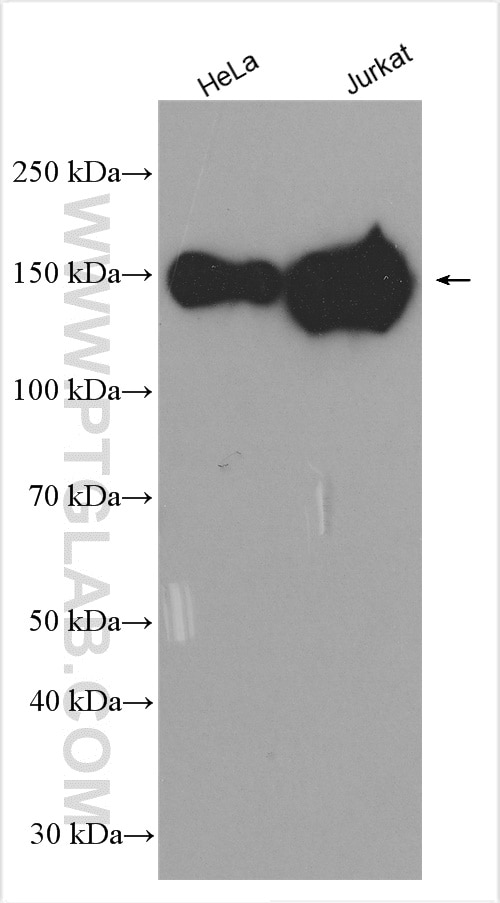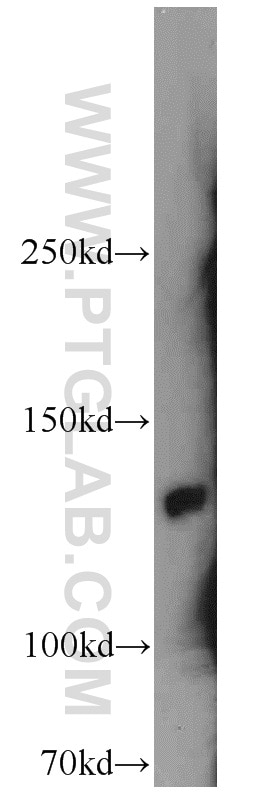- Phare
- Validé par KD/KO
Anticorps Polyclonal de lapin anti-SRRM1
SRRM1 Polyclonal Antibody for WB, IP, ELISA
Hôte / Isotype
Lapin / IgG
Réactivité testée
Humain, rat, souris
Applications
WB, IP, CoIP, ELISA
Conjugaison
Non conjugué
N° de cat : 12822-1-AP
Synonymes
Galerie de données de validation
Applications testées
| Résultats positifs en WB | tissu hépatique de souris, cellules HeLa, cellules Jurkat, HEK-293 traitées aux UV |
| Résultats positifs en IP | cellules HeLa |
Dilution recommandée
| Application | Dilution |
|---|---|
| Western Blot (WB) | WB : 1:500-1:1000 |
| Immunoprécipitation (IP) | IP : 0.5-4.0 ug for 1.0-3.0 mg of total protein lysate |
| It is recommended that this reagent should be titrated in each testing system to obtain optimal results. | |
| Sample-dependent, check data in validation data gallery | |
Applications publiées
| KD/KO | See 1 publications below |
| WB | See 2 publications below |
| CoIP | See 1 publications below |
Informations sur le produit
12822-1-AP cible SRRM1 dans les applications de WB, IP, CoIP, ELISA et montre une réactivité avec des échantillons Humain, rat, souris
| Réactivité | Humain, rat, souris |
| Réactivité citée | Humain |
| Hôte / Isotype | Lapin / IgG |
| Clonalité | Polyclonal |
| Type | Anticorps |
| Immunogène | SRRM1 Protéine recombinante Ag3513 |
| Nom complet | serine/arginine repetitive matrix 1 |
| Masse moléculaire calculée | 904 aa, 102 kDa |
| Poids moléculaire observé | 120-160 kDa |
| Numéro d’acquisition GenBank | BC036187 |
| Symbole du gène | SRRM1 |
| Identification du gène (NCBI) | 10250 |
| Conjugaison | Non conjugué |
| Forme | Liquide |
| Méthode de purification | Purification par affinité contre l'antigène |
| Tampon de stockage | PBS with 0.02% sodium azide and 50% glycerol |
| Conditions de stockage | Stocker à -20°C. Stable pendant un an après l'expédition. L'aliquotage n'est pas nécessaire pour le stockage à -20oC Les 20ul contiennent 0,1% de BSA. |
Informations générales
SRRM1, also named as SRM160 and POP101, contains one PWI domain and belongs to the splicing factor SR family. As part of pre- and post-splicing multiprotein mRNP complexes, SRRM1 is involved in numerous pre-mRNA processing events. It promotes constitutive and exonic splicing enhancer (ESE)-dependent splicing activation by bridging together sequence-specific (SR family proteins, SFRS4, SFRS5 and TRA2B/SFRS10) and basal snRNP (SNRP70 and SNRPA1) factors of the spliceosome. SRRM1 stimulates mRNA 3'-end cleavage independently of the formation of an exon junction complex. It binds both pre-mRNA and spliced mRNA 20-25 nt upstream of exon-exon junctions. SRRM1 binds RNA and DNA with low sequence specificity and has similar preference for either double- or single-stranded nucleic acid substrates. SRRM1, a protein of high molecular weight(120-160kd), has a heavy glycosylation level and is normally highly phosphorylated. This antibody is a rabbit polyclonal antibody raised against residues near the N terminus of human SRRM1.
Protocole
| Product Specific Protocols | |
|---|---|
| WB protocol for SRRM1 antibody 12822-1-AP | Download protocol |
| IP protocol for SRRM1 antibody 12822-1-AP | Download protocol |
| Standard Protocols | |
|---|---|
| Click here to view our Standard Protocols |
Publications
| Species | Application | Title |
|---|---|---|
Cell Host Microbe Quantitative phosphoproteomics reveals extensive cellular reprogramming during HIV-1 entry.
| ||
Biochim Biophys Acta Mol Cell Res Cleaved PGAM5 dephosphorylates nuclear serine/arginine-rich proteins during mitophagy. | ||
Tissue Cell SRRM1 promotes the proliferation, migration, and invasion of hepatocellular carcinoma cells by regulating the JAK/STAT signaling pathway |







